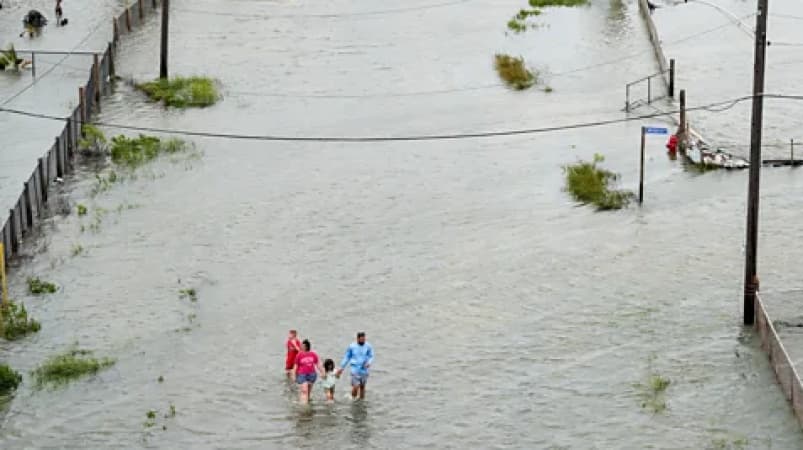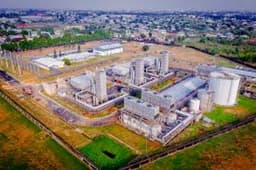
Flood water that aids spread of pathogens
Disease-causing microorganisms churn in the floodwaters after a hurricane and grow in people's homes long after the first danger has passed. But knowing when to seek medical attention can help limit the spread of disease after a storm.
Over the last seven years, Naresh Kumar and colleagues at the University of Miami have been steadily collecting data on hurricanes, from Maria in 2017 to Irma, Ian, Michael, Dorian and now the recent Hurricanes Helene and Milton, deadly storms which have all inflictedbillions of dollars of havocon the US.
But their focus was not on the damage to infrastructure wreaked by the storms, or the lives lost during the storm surge. Instead, they were focused on something far more subtle, and yet still deadly – how such natural disasters can fuel a whole plethora of infectious diseases.
This has been spotlighted by the recent aftermath of HurricaneHelenewhich hit Florida with storm surges and winds of up to 225km/h (140mph) before triggering flooding and landslides in western North Carolina. Florida health authorities releaseda warningin early October of a likely spike inVibrio vulnificusinfections, urging residents to avoid wading in floodwaters.
Vibrio vulnificusis a bacteria which can cause the breakdown of skin and soft tissue, sometimes leading to amputations. According to thelatest data, 77 cases and 15 deaths have been reported so far in 2024, the most recorded cases in the past decade, though it is not known how many of cases were reported since Helene and Milton. In 2022,Florida reportedan unusual increase inVibrio vulnificusinfections in the wake of Hurricane Ian.
"Vibrioprefers warmer waters, and hurricanes typically occur during times when the water is warmest," says John Drake, director of the centre for the ecology of infectious diseases at the University of Georgia. "Flooding associated with hurricanes could very well lead to a redistribution ofVibriofurther inland, and it goes without saying that there is increased human exposure to contaminated water when a hurricane hits."
Every year, the impacts of tropical cyclones – defined as storm systems with winds exceeding 119km/h (74mph) –affect an estimated 150 million peoplearound the world, mostly located in coastal communities. These storms encompass hurricanes which occur in the North Atlantic Ocean and Northeast Pacific, typhoons which form in the Northwest Pacific Ocean, and cyclones which begin in the South Pacific and the Indian Ocean.
Withsome forecastssuggesting that the intensity of tropical cyclones will grow with rising ocean temperatures, understandingthe full breadth of these storms' impact on diseaseis becoming increasingly urgent.
"We have been studying hurricanes for a while now and there are different pathways through which infectious diseases are exacerbated, mostly contaminated food, contaminated water and an increase in environmental pathogens," says Kumar.
One of the biggest impacts of hurricanes and other tropical cyclones is thought to be gastrointestinal infections, with communities in the storm's path becoming exposed to the kind of diseases which might traditionally be associated with extreme poverty.Studies havefound that hurricanes have caused spates of cholera across the American coastal south, whilea 2023 studynoted that typhoons in Taiwan had led to an increased burden of intestinal diseases, and infections which later progressed to sepsis.
According to Kumar, the reason for this is because extreme storms cause an enormous displacement of water, withstorm surges raising the water levelby 6m (19.7ft) or more, overwhelming or destroying sewage infrastructure, as well as introducing animal waste from farms into the water supply. If such pathogens work their way into rivers, they can then travel hundreds of miles.
"A certain amount of microbial contamination happens via these routes even through ordinary rainfall," says Kumar. "There's a programme in Floridacalled Healthy Beacheswhich shows thatthe concentrations of bacteria found in human wastejumps whenever there's a significant amount of rain."
The sheer force of the winds can disperse pathogenic bacteria, viruses and other microorganisms many kilometres into the atmosphere. A specialised aircraft developed by Nasadiscoveredthat a large number of bacteria and fungi had been dispersed to heights of up to 10,000m (33,000ft) by hurricanes Earl and Karl, severe storms which formed in August and September 2010. Together they affected the Atlantic coastlines of North and Central America stretching from Eastern Canada down to Mexico.
Drake says that such discoveries have already forced some municipalities with large sewage treatment facilities to develop emergency contingency plans to deal with hurricanes. Farms have had to adapt too.
"After Hurricane Floyd hit eastern North Carolina in 1999,the resulting flooding and rupture of swine lagoons[where pig manure is stored] led to a public health decree that changed how swine lagoons are built and managed," he says. "I think that the consequences of the atmospheric dispersion of such microorganisms need much more attention."
Once the floodwaters recede, the recovery and rebuilding process can begin. However, microbiologists are increasingly realising that an often-overlooked public health threat is the stagnant waterleft behindpooling in gardens, parts of the home and farmland, creating anideal breeding ground for mosquitoes.
Numerous studies have shown that theincidence of viral diseasessuch as West Nile, Zika, dengue and chikungunya, which are spread by mosquitoes, tends to increase in the aftermath of a hurricane.West Nile cases rosein Louisiana and Mississippi following Hurricane Katrina, dengue casesreportedly increasedin Puerto Rico following Hurricane Fiona and the risk of contracting Zikarose in Haitiafter Hurricane Matthew. While malaria has rarely been considered a public health threat in Canada, thereare growing concernsthat hurricanes hitting Canada's eastern border may be contributing to the rise of the disease in the south of the country.
"Having these standing water sources can change some of the dynamics in the local ecosystem in terms of the number of insects present," says Kimberly Davis, an associate professor at Johns Hopkins Bloomberg School of Public Health in Baltimore, Maryland.
Indoor flooding can also allow moulds to flourish, with even small leaks capable of inducing fungal growth in ventilation and air conditioning systems, affecting theair quality within homes,compromising breathing and aggravating the immune system. Studies found that flooding in Louisiana following hurricanes Rita and Katrinaled to an increase in the airborne fungiPenicilliumandAspergillus, whichcan causeallergies, respiratory infections and pneumonia.
Kumar tells the BBC that new, currently unpublished data from his research into the aftermath of hurricanes Maria, Irma and Michael, shows that a significant number of people in Florida developed new chronic health conditions such as asthma and allergies in the six months following the disasters, something which he suspects to have been triggered by the spread of moulds. He has also found that existing asthma patients can experience an acute exacerbation or an asthma attack in the immediate aftermath, and their symptoms worsen.
"In Florida, the Sun is still quite strong during hurricane season, through September and October, and water evaporates, and become airborne," says Kumar. "Because of this, you have a constant airborne concentration of more fungi in the air." Repairing damaged homes often takes precedence over seeking medical attention for their coughing and sneezing, Kumar says.
Kumar says that the long-term consequences of this for public health are often underestimated. "If you'd never previously been exposed to severe concentrations of black mould inside the home, and now you're chronically exposed to this, you could have allergies or asthma for the rest of your life and it might be life-threatening," he says. He remembers one case study after Hurricane Ian "where someone ended up staying in a mould-infected home and dying two or three months after the hurricane made landfall".
In some cases, the sheer amount of damage to healthcare infrastructure also limits access to medical care, especially for conditions deemed non-life threatening, with power outages and flooding forcing hospitals and pharmacies to close. In New Orleans following Hurricane Katrina,three major hospitals were surroundedby floodwater and remained closed for several months.
But not everyone in society faces the same level of risk. Gina Charnley, a global health researcher at Imperial College London, says that infectious diseases in the aftermath of natural disasters tend to disproportionately affect those in poverty.
"Following disasters, people who have the means and ability to move away from these risks tend to not get sick, and those who can't such as the elderly, pregnant women, or children, are the ones who most often get sick," she says. "Many infectious diseases globally could be reduced if we lift people out of poverty, but we have a long history of inaction on this."
Both Davis and Kumar believe that more needs to be done when it comes to identifying areas at the greatest risk in the aftermath of severe storms, and preventing, identifying and treating infections.
"There is a lot which we could do," says Kumar. "Mobile healthcare delivery systems at every single place where we anticipate people will congregate, including evacuation centres. You have to come to the affected communities where people might be at risk because otherwise they might not seek care and perish because of that. This is not only government responsibility, but of all healthcare providers, public and private." (BBC)



























NEWS EXPRESS is Nigeria’s leading online newspaper. Published by Africa’s international award-winning journalist, Mr. Isaac Umunna, NEWS EXPRESS is Nigeria’s first truly professional online daily newspaper. It is published from Lagos, Nigeria’s economic and media hub, and has a provision for occasional special print editions. Thanks to our vast network of sources and dedicated team of professional journalists and contributors spread across Nigeria and overseas, NEWS EXPRESS has become synonymous with newsbreaks and exclusive stories from around the world.